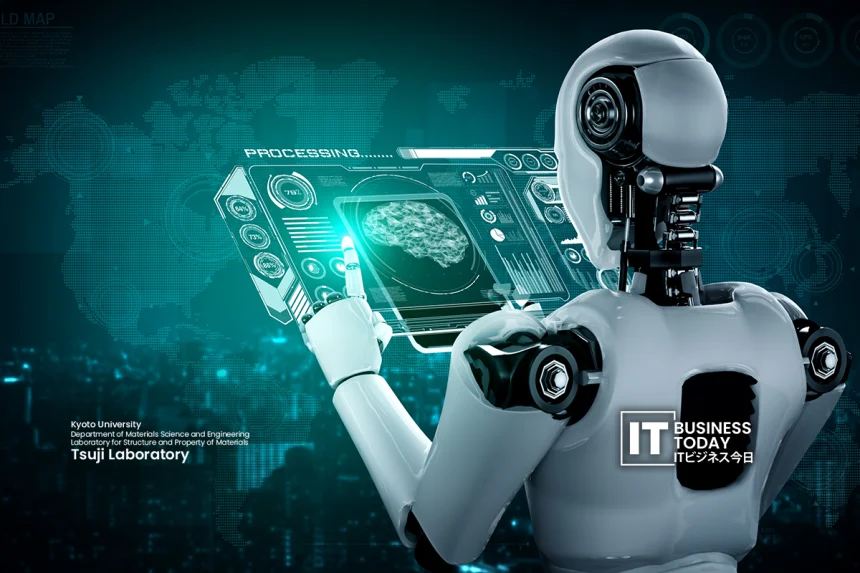Researchers at Saitama University (Tsuji Laboratory) have succeeded in digitalizing and automating an artisan polishing technique a process that historically depends on the refined judgment and hands of master craftsmen. Their newly developed Physical AI robot can reproduce delicate, aesthetically rich polished patterns on metal surfaces, generating subtle and unique motifs each time, mimicking an artisan’s touch.
This achievement is impressive for both the robot’s performance and its significance. It blends generative AI, robotics, and skilled craftsmanship. This mix tackles the lack of human labor and aids in knowledge transfer. Below, we look at how this news could impact Japan’s tech industry. We’ll look at how it impacts businesses in robotics, smart manufacturing, and AI.
Why This Breakthrough Is Significant
1. Digitizing Tacit Craft Knowledge
One of the hardest things to automate is the kind of knowledge that resides in a craftsman’s intuitive touch, the micro-adjustments, feedback loops, and subtle variations that distinguish handcrafted beauty from mechanical uniformity. By enabling a robot to generate unique patterns rather than repeating fixed templates, Saitama’s team is pushing toward automation that retains aesthetic richness and variability.
This is more than merely replicating patterns; it’s an example of ‘Physical AI,’ coupling generative models with robotic actuation to manifest creative, physical outputs. In effect, the system learns not just what to produce, but how to vary in response to material feedback.
2. Addressing Labor Shortages and Succession of Skills
Japan is dealing with both declining birth rates and an aging workforce. In many traditional manufacturing sectors, the transfer of artisan skills is threatened. The demonstration suggests a path toward preserving craft legacies, even when few human experts remain. Enterprises struggling with skilled labor gaps may find promise in such hybrid approaches.
Also Read: nematsu Partners with Intuition Robotics to Launch AI Companion Robot ElliQ in Japan
Impacts on the Japanese Tech & Manufacturing Ecosystem
A. Surge in Physical AI and Creative Robotics
This demonstration may spur further research and investment into robots that don’t just perform mechanical tasks but creatively interact with materials. We may see more projects combining generative AI (for design/motif) and actuation/robotics to produce objects with aesthetic or artistic value, in sectors like luxury goods, jewelry, high-end metalwork, furniture, or decorative components.
Startups and universities will likely compete or collaborate to scale such systems, improving speed, precision, material variety (beyond metal, to wood, ceramics, glass), and integration with techniques like polishing, engraving, sculpting, or surface finishing.
B. Redefining Automation in High-End Manufacturing
In high-value manufacturing, the question isn’t just, ‘Can we automate this? Can we automate it while keeping or improving its artistic and functional details?’ If robots can achieve artisan-level precision, companies making premium goods, like automotive trim, watch cases, high-quality parts, and designer hardware, could speed up production, reduce defects, and depend less on rare human artisans.
C. Complementary Technologies & Enablers
To make this more scalable, supporting technologies will become more important:
- Sensing & feedback instrumentation (tactile, visual, force) to guide the robot’s microadjustments
- Better models and control loops to blend AI-generated proposals with sensor corrections
- Material science integration to understand how surface, hardness, abrasives, polish media all interact
- Software platforms for fine-tuning and customizing motifs so customers might order custom finishes or patterns
This may foster a growing ecosystem (tools, modules, IP, software) around creative robotics.
Effects on Businesses in This Domain
For Robotics & Automation Companies
- New Product Differentiation: Robotics companies could begin marketing not only speed or precision but aesthetic flexibility and adaptive craftsmanship.
- Collaborations & Licensing: Firms may license pattern-generation modules, or partner with universities to embed their algorithms in robotic arms.
- Upgrading older lines: Factories with existing robotic infrastructure might retrofit or upgrade with ‘creative overlays’ for finishing steps.
For Luxury / Precision Manufacturing Firms
- Customization at scale: Brands may offer limited-edition or bespoke patterning as a value add, done on demand by robotically controlled finishing.
- Cost and time reduction: Automating previously artisan-bound processes could reduce labor bottlenecks, lower costs, and cut delivery timelines, particularly when artisanal labor is scarce or expensive.
- Quality consistency with flair: Machines can maintain consistency while still introducing variation that feels handcrafted, potentially appealing to discerning customers.
For AI & Software Providers
- Design-to-physical workflows: Opportunities to develop pipeline software that allows designers to sketch a motif, then translate it into robot instructions, simulate, adjust, and refine.
- Generative model specialization: Companies may build or specialize generative models tuned to particular material constraints, polishing characteristics, or artistic styles.
Challenges and Considerations
- Physical robustness: Real-world materials and wear conditions may introduce imperfections, robots must adapt to variations, surface defects, and noise.
- Scaling across materials and shapes: Extending this from metal panels to curved shapes, organic forms, or composite materials is nontrivial.
- Cost and ROI: Initial capital expenses will be high; businesses will weigh whether artisan labor costs justify investment.
- Intellectual property and aesthetic rights: When motifs are generated algorithmically, who owns the pattern? This will require legal frameworks.
- Acceptance by artisans and market: Some markets prize the ‘hand-made’ narrative. Convincing buyers that robot-assisted craftsmanship remains authentic may require marketing and trust.
Outlook
The Saitama University Tsuji Lab’s robot is a striking signal that automation and art can coexist, not simply by mimicking human movements but by learning and generating creative variation itself. At CEATEC 2025, this Physical AI robot aims to bridge the gap between tradition and technology.
In the next several years, we may see more demonstrations of robots combining generative AI with fine control, leading to new hybrid forms of manufacturing. For Japan, and for firms globally, the ability to automate not just function but aesthetic nuance could open new competitive frontiers in premium goods, customized finishes, and creative industrial design.






